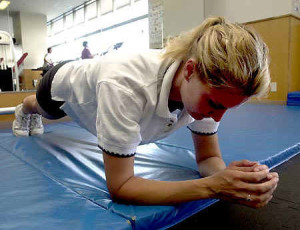Dear Doug-
A friend of mine, who is a Beachbody Coach (Beachbody being the fitness company selling P90x, etc), was chatting up core training with me and what I can do to strengthen my back. I had mentioned to him that I recently strained my lower back when I broke form putting away a kettle bell. I must admit that I had been neglecting my core a bit and was likely not ready for the Squat-Swing +35lbs in the first place. He mentioned a drill which he called “Superman to Banana”. You can imagine exactly what it is. You roll from Superman position to something the “opposite” of a Superman.
I asked him:”Doesn’t that drill put excessive compressive load on your spine?. Is it a safe drill?” He conceded that it wasn’t one that should be done under injury and that it is an advanced drill but he’s had great success with it.
But then he said something which peaked my interest: “If Superman is a dangerous drill, then so is Yoga: Down Dog specifically because you arch your back in a similar manner, so if Superman is a dangerous drill, it might be for a different reason other than purely compressive spinal stress. Anyway, please let me know what your PT friend thinks about this because I’d hate to be telling my clients to do the wrong stuff.”
So, there is the crux of my comment and question. Can you clarify, perhaps some of the differences between Down Dog and the Superman and why one may be safer than the other (or not)?
Thanks, man.
Hi Omar –
You’re correct about the Superman (lying face down, lift arms, legs, head and trunk and hold) being an unsafe drill. Very high spinal compression loads. There’s no reason to do it. Ever. Same with the “banana”.
As for Downward Dog, that drill does not require active extension of the trunk as the Superman drill does. When done properly, you maintain a spine neutral position with the movement coming primarily from the ankles, hips, shoulders, upper back. The load is distributed through the arms/shoulders with low loads on the spine (assuming one can achieve spine neutral). I’m not sure what your friend means when he says, “you arch your back in a similar manner”. The pose does not require you to arch your back into extension or really move it at all (although people with insufficient hip and ankle mobility will likely flex in the lumbar spine).
As for yoga in general, sure there are plenty of movements and positions that are risky. The teacher and participant should understand which movements and poses are the safest and achieve the objective.

